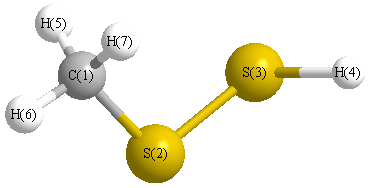Vibrational Frequencies calculated at PBEPBE/cc-pVTZ
| Mode Number |
Symmetry |
Frequency
(cm-1) |
Scaled Frequency
(cm-1) |
IR Intensities
(km mol-1) |
Raman Act
(Å4/u) |
Dep P |
Dep U |
|---|
| 1 |
A |
3076 |
3054 |
5.93 |
59.32 |
0.75 |
0.86 |
| 2 |
A |
3059 |
3038 |
5.78 |
93.15 |
0.74 |
0.85 |
| 3 |
A |
2972 |
2952 |
16.10 |
199.21 |
0.03 |
0.06 |
| 4 |
A |
2530 |
2513 |
10.08 |
183.99 |
0.25 |
0.39 |
| 5 |
A |
1424 |
1414 |
8.86 |
8.07 |
0.74 |
0.85 |
| 6 |
A |
1402 |
1392 |
8.65 |
9.47 |
0.75 |
0.86 |
| 7 |
A |
1285 |
1276 |
2.08 |
1.90 |
0.50 |
0.67 |
| 8 |
A |
937 |
930 |
5.19 |
2.50 |
0.39 |
0.56 |
| 9 |
A |
932 |
926 |
4.51 |
2.15 |
0.50 |
0.67 |
| 10 |
A |
845 |
839 |
4.61 |
20.06 |
0.54 |
0.70 |
| 11 |
A |
670 |
665 |
2.90 |
10.36 |
0.23 |
0.37 |
| 12 |
A |
495 |
492 |
0.78 |
8.46 |
0.21 |
0.35 |
| 13 |
A |
331 |
328 |
12.55 |
6.60 |
0.75 |
0.86 |
| 14 |
A |
231 |
229 |
0.23 |
5.75 |
0.56 |
0.72 |
| 15 |
A |
158 |
157 |
0.47 |
0.02 |
0.62 |
0.77 |
Unscaled Zero Point Vibrational Energy (zpe) 10172.7 cm
-1
Scaled (by 0.9931) Zero Point Vibrational Energy (zpe) 10102.5 cm
-1
See section
III.C.1 List or set vibrational scaling factors
to change the scale factors used here.
See section
III.C.2
Calculate a vibrational scaling factor for a given set of molecules
to determine the least squares best scaling factor.
Charges, Dipole, Quadrupole and Polarizability
Charges from optimized geometry at PBEPBE/cc-pVTZ
Charges (e)
| Number |
Element |
Mulliken |
CHELPG |
AIM |
ESP |
| 1 |
C |
-0.265 |
|
|
|
| 2 |
S |
-0.055 |
|
|
|
| 3 |
S |
-0.124 |
|
|
|
| 4 |
H |
0.104 |
|
|
|
| 5 |
H |
0.122 |
|
|
|
| 6 |
H |
0.106 |
|
|
|
| 7 |
H |
0.112 |
|
|
|
Electric dipole moments
Electric dipole components in Debye
(What's a Debye? See section
VII.A.3)
| |
x |
y |
z |
Total |
| |
-1.025 |
1.172 |
0.778 |
1.741 |
| CHELPG |
|
|
|
|
| AIM |
|
|
|
|
| ESP |
|
|
|
|
Electric Quadrupole moment
Quadrupole components in D Å
| Primitive |
|---|
| | x | y | z |
|---|
| x |
-30.794 |
-0.158 |
1.569 |
| y |
-0.158 |
-34.861 |
0.552 |
| z |
1.569 |
0.552 |
-33.164 |
|
| Traceless |
|---|
| | x | y | z |
|---|
| x |
3.219 |
-0.158 |
1.569 |
| y |
-0.158 |
-2.882 |
0.552 |
| z |
1.569 |
0.552 |
-0.337 |
|
| Polar |
|---|
| 3z2-r2 | -0.674 |
|---|
| x2-y2 | 4.067 |
|---|
| xy | -0.158 |
|---|
| xz | 1.569 |
|---|
| yz | 0.552 |
|---|
|
Polarizabilities
Components of the polarizability tensor.
Units are
Å
3 (Angstrom cubed)
Change units.
| |
x |
y |
z |
| x |
10.344 |
0.239 |
0.193 |
| y |
0.239 |
6.847 |
0.098 |
| z |
0.193 |
0.098 |
5.962 |
<r2> (average value of r
2) Å
2
| <r2> |
103.397 |
| (<r2>)1/2 |
10.168 |
